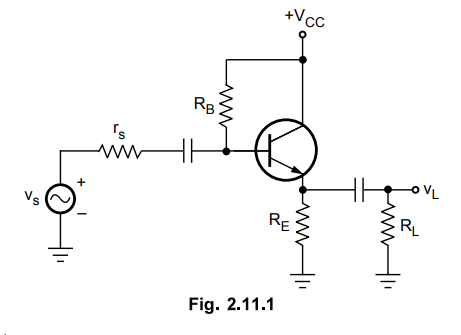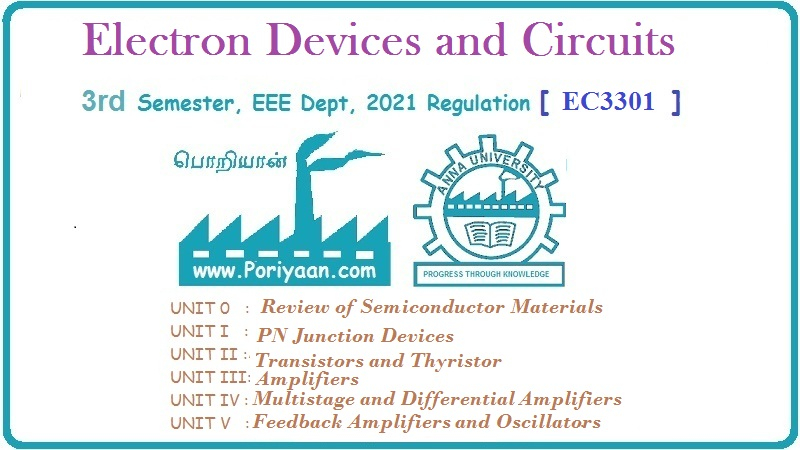Electron Devices and Circuits: Unit II: (a) Bipolar Junction Transistors (BJT)
University Questions with Answers (Long Answered Questions)
Bipolar Junction Transistors (BJT) | Electron Devices and Circuits
Electron Devices and Circuits: Unit II: (a) Bipolar Junction Transistors (BJT) : University Questions with Answers (Long Answered Questions)
University Questions with Answers (Long Answered Questions)
(Regulation
2008)
Dec.-09
Q.1
Explain the method of stabilizing the Q point. [Section 2.9] [16]
May-10
Q.2
Draw a self (voltage divider) bias and derive all the stability factors S, S'
and S" [Section 2.8] [16]
Q.3
Explain the circuit which uses a diode to compensate for changes in VBE and in
Ico. [Section 2.9] [8]
Q.4
Discuss the operation of thermistor compensation. [Section 2.9] [4]
Dec.-10
Q.5
Draw a block diagram of an unbiased npn transistor. Identify each part of the
device depletion and show the regions and barrier voltages. Briefly explain.
[Section 2.3] [5]
Q.6
Sketch and explain the input characteristics of transistor in CE mode. [Section
2.4] [5]
Q.7
With a neat diagram explain output characteristics of npn transistor in
CE-configuration. [Section 2.4] [5]
Q.8
Draw a self (voltage divider) bias and derive all the stability factors S, S'
and S" [Section 2.8] [16]
May-11
Q.9
Sketch and explain the input characteristics of transistor in CE mode. [Section
2.4] [5]
Q.10
With a neat diagram explain output characteristics of npn transistor in
CE-configuration.
[Section
2.4] [5]
Q.11
Derive the expression of stability factor for collector feedback amplifier.
[Section 2.8] [8]
May-12
Q.12
What is transistor ? [Section 2.1] [3]
Q.13
Explain the terms emitter, collector and base. [Section 2.2] [3]
Q.14
Sketch the symbols of transistors. [Section 2.2] [3]
Q.15
Sketch the symbols of transistors and mark the current directions. [Section
2.3] [4]
Q.16 Explain the operation of NPN transistor in CE
configuration with it’s input and output characteristics. Also define active,
saturation and cut-off regions.
[Section 2.4] [16]
Q.17 Compare CB, CE and CC transistor configurations.
[Section 2.4] [8]
Q.18
Draw a voltage divider bias BJT network. Derive expressions for fCQ and VCEQ
and describe the method of drawing the d.c. load line on the output
characteristics of transistor. [Section 2.8] [16]
Q.19
Comment on fixed biasing in BJT. Explain the procedure for locating suitable
operating point on the characteristic curves. [Section 2.8] [10]
Dec.-12
Q.20
Explain the method of stabilizing the Q point. [Section 2.9] [16]
Q.21
Explain bias compensation. [Section 2.9] [8]
May-13
Q.22
Sketch and explain the input characteristics of transistor in CE mode. [Section
2.4] [5]
Q.23
With a neat diagram explain output characteristics of npn transistor in
CE-configuration. [Section 2.4] [5]
Q.24 Explain the method of stabilizing the Q point. [Section 2.9] [16]
Q.25 Explain bias compensation. [Section 2.9][8]
Dec.-13
Q.26 Sketch and explain the input characteristics
of transistor in CE mode. [Section 2.4][5]
Q.27 Compare CB, CE and CC transistor configurations. [Section 2.4] [8]
Q.28
Draw a self (voltage divider) bias and derive all the stability factors S, S'
and S" [Section 2.8] [16]
May-14
Q.29
Sketch and explain the input characteristics of transistor in CB mode. [Section
2.4]
Q.30
With a neat diagram explain the output characteristics of transistor in CB
mode. [Section 2.4] [8]
Q.31
Explain the input I output characteristics of BJT in common base configuration.
[Section 2.4] [11]
Q.32
Compare CE, CB and CC configurations of BJT. [Section 2.4] [5]
(Regulation 2013)
Dec.-14
Q.33
Explain the construction and operation of NPN transistor with neat sketch. Also
comment on the characteristics of NPN transistor. [Section 2.2] [16]
Q.34
Explain the construction and operation of NPN transistor with neat sketch. Also
comment on the characteristics of NPN transistor. [Section 2.3] [16]
Dec.-15
Q.35
Explain the selection of Q point for a transistor bias circuit and discuss the
limitations on the output voltage swing. [Section 2.5.5] [8]
Q.36
Discuss the factors involved in the selection of IC,RC ar,d RE f°r a single
stage common emitter BJT amplifier circuit, using voltage divider bias [Refer
example 2.8.4] [8]

Ans. :
The
value of Rc and hence IC should be such that transistor will operate in active
region.
May-17
Q.37
Design a voltage divider bias circuit for transistor to establish the quiescent
point at VEE = 12 V, IQ = 1.5 mA, stability factor S ≤ 3, β = 50, VBE = 0.7 V,
Vcc = 22.5 V and Rc = 5.6 k Ω.
[Refer
example 2.8.11] [15]
Dec.-17
Q.38
Explain the emitter bias method used in transistor amplifier circuits. [Section
2.8.4] [5]
Q.39
Compare the characteristics of CB, CE and CC amplifiers. [Section 2.4.4] [7]
Electron Devices and Circuits: Unit II: (a) Bipolar Junction Transistors (BJT) : Tag: : Bipolar Junction Transistors (BJT) | Electron Devices and Circuits - University Questions with Answers (Long Answered Questions)
Related Topics
Related Subjects
Electron Devices and Circuits
EC3301 3rd Semester EEE Dept | 2021 Regulation | 3rd Semester EEE Dept 2021 Regulation
